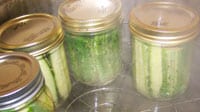
Once you heat, or even soak, vegetables in a pickling solution, pH changes start to happen. (Heating makes the interaction happen faster.) The vegetables become more acidic, which is desirable in pickling. However, the pickling solution then becomes less acidic. So if the pickle recipe uses the hot pack method, and the vegetables have been heated in the pickling solution (“brine”), then the leftover brine should not be used for another recipe. The expected ratio of acid to low-acid ingredients and ultimate pH adjustment in the next recipe will not be the same.
In some recipes, sliced raw cucumbers are soaked for hours in the pickling liquid (vinegar, sugar and/or salt, for example). Then the liquid is drained off the cucumber slices. The soaked raw slices are filled into jars while the liquid is then heated and poured over them. Even though this is a raw pack in terms of filling jars, this vinegar solution had its original pH (acidity) altered from that initial soaking before it was heated and poured into jars. It should not be used again for a canned pickle recipe since it is now of unknown acidity.
Source: The National Center for Home Food Preservation, University of Georgia
